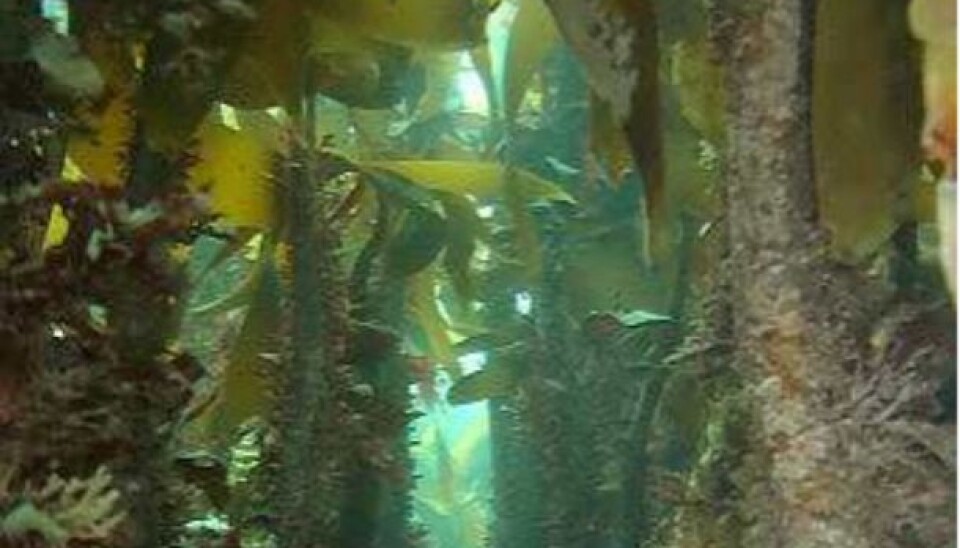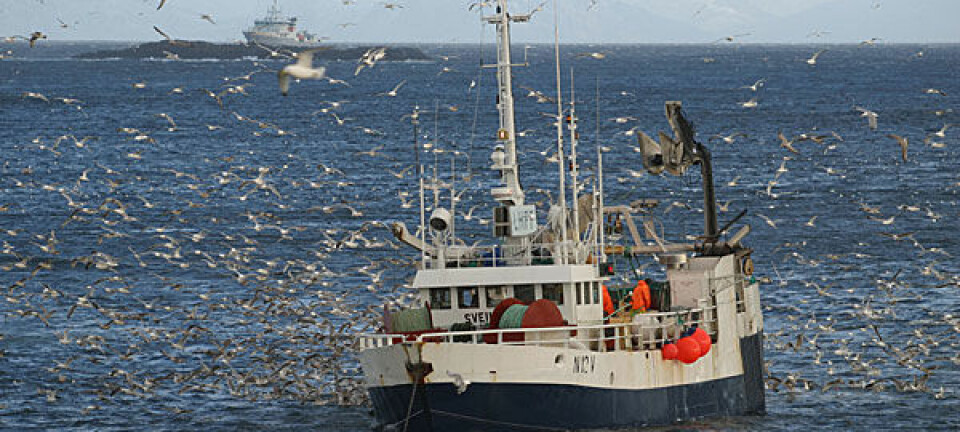An article from NIVA - Norwegian Institute for Water Research

Less fish without kelp
Fishermen in Norway are worried about reduced catches. In their opinion, kelp harvesting is to blame for the disappearance of coastal fish species.
Denne artikkelen er over ti år gammel og kan inneholde utdatert informasjon.
Kelp forests serve as feeding and breeding areas for small animals, seabirds and fish. Grazing by sea urchins and kelp trawler harvesting create disturbances that lead to diminished biological diversity.
Every year, about 160 000 tons of kelp is harvested in the coastal areas between Rogaland and Trøndelag in Norway. The kelp is used to produce alginate, a thickener used in food, animal feed and paint. Alginate is also used in the development of medical and biotechnological products.
Researchers have acquired new knowledge of the distribution of kelp forests, its biological diversity and harvesting potential. This knowledge, they argue, must now be applied.
"The division of coastal areas into trawling sectors was done in the 1970’s and should be reconsidered," says research scientist Eli Rinde at the Norwegian Institute for Water Research (NIVA).

"We have more information and have developed tools that can be used to devise optimal harvest strategies that take into account the needs of the kelp industry and other industries as well as the conservation of biological diversity."
Commercial interests and biological diversity
While commercial interests are important, some areas must be allowed to develop as “natural forests” in the same way as forests on land, according to Rinde.
She says that this is needed to ensure that species that spread slowly get the necessary conditions to live, and that it is particularly relevant in areas where the kelp forest can be subjected to clear-felling.
These are typically large areas where the ocean floor is flat and even and the kelp trawl doesn’t get stuck.
"These areas can easily be identified by terrain modeling. We need to make sure that a sufficiently large area with optimal growth conditions for kelp can develop naturally," Rinde says.
Sustainable management
Kelp areas that have recently been trawled will have less fish for a couple of years if a substantial part of the kelp is harvested. Careful planning where different interests are balanced against one another will lead to less conflict of interest.
"Kelp is a renewable resource that it should be possible to manage sustainably," says Rinde.
This means taking into account both ecology and conservation interests as well as different commercial interests such as kelp trawling, fishing and aquaculture. These kinds of considerations are being applied in the district of Sogn and Fjordane where kelp harvesting has been subjected to a new regulatory regime from 2011.
Consequences of kelp trawling
"For an area to recover completely after trawling, both kelp plants and the natural flora and fauna that belong there must have time to reestablish," Rinde stresses.
Each area is harvested every five years. The kelp forest needs 3-5 years to develop the same biomass as before the harvesting took place. However, the flora and fauna is probably not properly reestablished until the kelp plants reach their maximum age - this means between eight and ten years.
"With today’s frequency of harvesting biodiversity will not be completely reestablished between each harvesting cycle," says Rinde.
Kelp plants are important habitats for a great number of individuals and species of small animals. The number of species of “epiphytes” (algae that settle on the stem of the kelp) increase with the age of the kelp plant, and the number of associated species of small animals increases with the quantity and number of species of settled algae.
Growth conditions for a diverse society of epiphytes deteriorate in areas that have been trawled because the kelp population is made up of individuals of the same size and age, causing shadowing and low light levels.
The age and size distribution of kelp plants and the amount of associated flora and fauna will vary from north to south along the coast, but will also be affected by depth and exposure to waves and currents locally.
Local variations
Rinde explains that there are local variations in the production, diversity and dispersion of species along these gradients, but it is still uncertain whether plant and animal communities have different sensitivity to disturbances such as harvesting, grazing by sea urchins and storm incidents along the same gradients.
"There is also little knowledge about rare species in marine coastal ecosystems, and we can’t exclude that high trawling intensity in habitats with rare, slow spreading species, can lead to a reduction in the populations ability to survive," says Rinde.
The ecological consequences of kelp trawling in a large area will depend on how efficiently an area is trawled and the amount of kelp forest that is left untouched. This will vary with seabed conditions.
In hilly areas, parts of the kelp forest will be left untouched because they are not accessible for the trawlers. On flat and even seabeds larger areas will be accessible for trawling.
"The same principles apply here as with forests on land: clear-felling of kelp forests in the ocean will make it difficult for certain groups of small animals and plants to reestablish themselves if they have a low spreading potential and the distance to the nearest untrawled kelp forest is too large," says Rinde.
Old management regime
The division of ocean areas into sectors for commercial trawling was done early in the history of the industry.
"This was before we had any knowledge about the distribution of kelp forests and before we knew about the effects of fragmenting a nature type," Rinde stresses.
The coast from Jæren to Trøndelag is divided into harvesting fields, or parallel zones that stretch from land and outwards into the archipelago. The size of each field is about one nautical mile wide (1.85 km). Each field is further divided into 5 zones (A, B, C, D and E). Each zone is normally open to trawling every fifth year.
Due to differences in terrain structure, depth distribution and physical factors, the available kelp biomass within each zone varies a lot within and between fields. The trawl is a three meter wide steel rake that harvests all the large kelp plants. The small plants that are left ensure a rapid regrowth of the kelp forest.
The use of models
"Through the development of kelp forest modeling and the mapping of kelp forests within the National Program for Mapping and Monitoring Biological Diversity we now have a good overview of where the most important areas of kelp forest are located," says Rinde.
"We also know a lot about important habitats for seabirds and other organisms that can be affected by kelp trawling. In particular, this relates to effects that occur in trawling periods and in the years following immediately after."
The scientists have tools for planning and securing a sustainable use of the resources in the coastal zone that accommodate conflicting interests. These are geographic information system (GIS) tools and maps of the distribution of kelp forests, estimated kelp biomass and hot spot areas for biodiversity and maps that identify areas of different commercial interests such as fisheries, aquaculture facilities and kelp trawling
Kelp forest advances
In the 1970’s, the kelp forest in South-Trøndelag had been deforested by green sea urchins. The forest in this area reestablished itself in the early 1990’s but there are still high density pockets of sea urchins in protected coastal zones. The area was opened for trial trawling in 1997.
Sea urchin deforestation of the kelp forest has large consequences for coastal fisheries in affected areas.
"How stable the positive development of the kelp is in relation to sea urchin grazing in Trøndelag is uncertain, and there is a need to follow up the development of this relationship closely associated with kelp trawling," says Rinde.
--------------------------------------------------------
Read the article in Norwegian at forskning.no
































